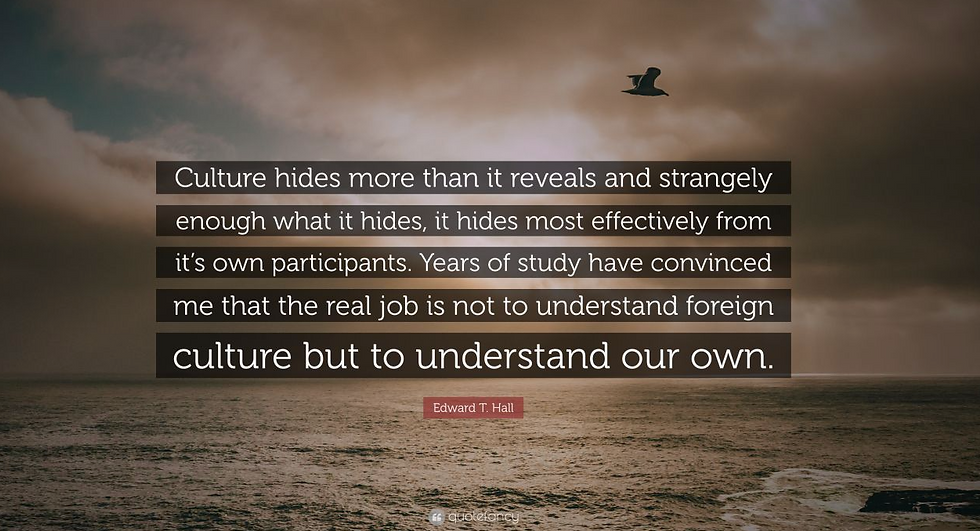- culturebumpteam
- May 5, 2021
- 3 min read
Updated: Nov 3, 2021

What is "cultural humility"? Hook, Davis, Owen, Worthington and Utsey (2013) defined cultural humility as the “ability to maintain an interpersonal stance that is other-oriented (or open to the other) in relation to aspects of cultural identity that are most important to the person." The crux of the problem with being able to develop this ability has long been understood. It has been described in various ways—from McLuhan's "fish in the water" to Edward Hall's 1959 observation about culture below.

More recently, Julia Sufrin asserts,
"Because the overall purpose of practicing cultural humility is to be aware of one’s own values and beliefs, it is important to understand that those notions come from the combination of cultures that people experience in their everyday lives. A person cannot begin to understand the makeup and context of another person’s life without being aware and reflective of their own background and situation first."
So how can we become aware and reflective of our own background and situation?
The Culture Bump 8 Steps provide a structured path that guides us through a self reflective process that leads to both self- and other awareness. And because we have constant culture bumps with one another, we have a life-long reflection that leads to learning—and the continuous practice of cultural humility.
How exactly do the Steps lead us into practicing cultural humility?
7 of the 8 Culture Bump Steps specifically train us to practice cultural humility. Below, those 7 Steps are ordered to explicitly explain the correlation between developing Cultural Humility and practicing the Culture Bump Steps.
Step One (Pinpoint a difference) ….Paying attention to what catches our attention.
Only when our perception is juxtaposed against a differing perception do we become aware that our perception is not REALITY but is OUR REALITY.
With Step One we become conscious
Step Two (Describe what the other person did)…
Step Three (Describe what you did)…
With Steps Two and Three we become conscious of behavior
Step Six (Describe what you would do or expect others to do in a particular situation)…
Reveals our cultural blind spots
With Step Six we become conscious of a pattern of behaviors that we expect from ourselves and others.
Step Five ( Find a Universal situation in the incident)...
With Step Five we become conscious that all other human beings face the same trivial (or major) life situations that we encounter every day.
Step Seven (List the qualities you feel that action demonstrates)…
Discover exactly what it means to us when we do what we do
Become conscious of the nuances of our culturally shared knowledge
Step Eight (Ask or think about how those qualities are demonstrated by other people)…
Connect with individuals with whom we hold opposite points of view without losing our own point of view
We begin consciously exploring how we human beings are the same.

So how can you begin to develop Cultural Humility? It begins by examining your "culture bumps" with other people with the Culture Bump Steps. Click here to use the Culture Bump 8 Step Tool. Check your answers using this Quiz for your level of Cultural Humility.
Hall, Edward T. (1959) The Silent LanguageT. Garden City, NY: Anchor Press.
Hook, J. N., Davis, D. E., Owen, J., Worthington Jr., E. L., & Utsey, S. O. (2013). Cultural humility: Measuring openness to culturally diverse clients. Journal of Counseling Psychology®. doi:10.1037/a0032595
McLuhan, Marshall. (1968) War & Peace in the Global Village. Corte Madera, Cal: Ginko Press.
Sufrin, Julia (2019 0 3 Things to Know about cultural humility (Hogg Foundation for Mental Health) https://hogg.utexas.edu/3-things-to-know-cultural-humility


Comments